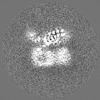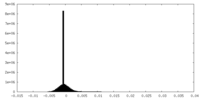[English] 日本語
 Yorodumi
Yorodumi- EMDB-20192: Structure of the TRPV3 K169A sensitized mutant in apo form at 4.1... -
+ Open data
Open data
- Basic information
Basic information
| Entry | Database: EMDB / ID: EMD-20192 | |||||||||
|---|---|---|---|---|---|---|---|---|---|---|
| Title | Structure of the TRPV3 K169A sensitized mutant in apo form at 4.1 A resolution. | |||||||||
 Map data Map data | Full map | |||||||||
 Sample Sample |
| |||||||||
 Keywords Keywords | Ion channel / TRP channel / TRPV channel / Metal transport / Membrane transport / membrane protein / TRANSPORT PROTEIN | |||||||||
| Function / homology |  Function and homology information Function and homology informationnegative regulation of hair cycle / TRP channels / response to temperature stimulus / sodium channel activity / positive regulation of calcium ion import / calcium ion import across plasma membrane / calcium channel activity / calcium ion transmembrane transport / lysosome / receptor complex ...negative regulation of hair cycle / TRP channels / response to temperature stimulus / sodium channel activity / positive regulation of calcium ion import / calcium ion import across plasma membrane / calcium channel activity / calcium ion transmembrane transport / lysosome / receptor complex / identical protein binding / plasma membrane / cytoplasm Similarity search - Function | |||||||||
| Biological species |  Homo sapiens (human) Homo sapiens (human) | |||||||||
| Method | single particle reconstruction / cryo EM / Resolution: 4.1 Å | |||||||||
 Authors Authors | Zubcevic L / Borschel WF | |||||||||
| Funding support |  United States, 2 items United States, 2 items
| |||||||||
 Citation Citation |  Journal: Elife / Year: 2019 Journal: Elife / Year: 2019Title: Regulatory switch at the cytoplasmic interface controls TRPV channel gating. Authors: Lejla Zubcevic / William F Borschel / Allen L Hsu / Mario J Borgnia / Seok-Yong Lee /  Abstract: Temperature-sensitive transient receptor potential vanilloid (thermoTRPV) channels are activated by ligands and heat, and are involved in various physiological processes. ThermoTRPV channels possess ...Temperature-sensitive transient receptor potential vanilloid (thermoTRPV) channels are activated by ligands and heat, and are involved in various physiological processes. ThermoTRPV channels possess a large cytoplasmic ring consisting of N-terminal ankyrin repeat domains (ARD) and C-terminal domains (CTD). The cytoplasmic inter-protomer interface is unique and consists of a CTD coiled around a β-sheet which makes contacts with the neighboring ARD. Despite much existing evidence that the cytoplasmic ring is important for thermoTRPV function, the mechanism by which this unique structure is involved in thermoTRPV gating has not been clear. Here, we present cryo-EM and electrophysiological studies which demonstrate that TRPV3 gating involves large rearrangements at the cytoplasmic inter-protomer interface and that this motion triggers coupling between cytoplasmic and transmembrane domains, priming the channel for opening. Furthermore, our studies unveil the role of this interface in the distinct biophysical and physiological properties of individual thermoTRPV subtypes. | |||||||||
| History |
|
- Structure visualization
Structure visualization
| Movie |
 Movie viewer Movie viewer |
|---|---|
| Structure viewer | EM map:  SurfView SurfView Molmil Molmil Jmol/JSmol Jmol/JSmol |
| Supplemental images |
- Downloads & links
Downloads & links
-EMDB archive
| Map data |  emd_20192.map.gz emd_20192.map.gz | 58.7 MB |  EMDB map data format EMDB map data format | |
|---|---|---|---|---|
| Header (meta data) |  emd-20192-v30.xml emd-20192-v30.xml emd-20192.xml emd-20192.xml | 15.2 KB 15.2 KB | Display Display |  EMDB header EMDB header |
| Images |  emd_20192.png emd_20192.png | 77.7 KB | ||
| Filedesc metadata |  emd-20192.cif.gz emd-20192.cif.gz | 5.8 KB | ||
| Others |  emd_20192_half_map_1.map.gz emd_20192_half_map_1.map.gz emd_20192_half_map_2.map.gz emd_20192_half_map_2.map.gz | 45.8 MB 45.8 MB | ||
| Archive directory |  http://ftp.pdbj.org/pub/emdb/structures/EMD-20192 http://ftp.pdbj.org/pub/emdb/structures/EMD-20192 ftp://ftp.pdbj.org/pub/emdb/structures/EMD-20192 ftp://ftp.pdbj.org/pub/emdb/structures/EMD-20192 | HTTPS FTP |
-Validation report
| Summary document |  emd_20192_validation.pdf.gz emd_20192_validation.pdf.gz | 946.4 KB | Display |  EMDB validaton report EMDB validaton report |
|---|---|---|---|---|
| Full document |  emd_20192_full_validation.pdf.gz emd_20192_full_validation.pdf.gz | 945.9 KB | Display | |
| Data in XML |  emd_20192_validation.xml.gz emd_20192_validation.xml.gz | 11.9 KB | Display | |
| Data in CIF |  emd_20192_validation.cif.gz emd_20192_validation.cif.gz | 13.9 KB | Display | |
| Arichive directory |  https://ftp.pdbj.org/pub/emdb/validation_reports/EMD-20192 https://ftp.pdbj.org/pub/emdb/validation_reports/EMD-20192 ftp://ftp.pdbj.org/pub/emdb/validation_reports/EMD-20192 ftp://ftp.pdbj.org/pub/emdb/validation_reports/EMD-20192 | HTTPS FTP |
-Related structure data
| Related structure data | 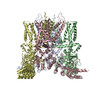 6ot2MC  6ot5C C: citing same article ( M: atomic model generated by this map |
|---|---|
| Similar structure data |
- Links
Links
| EMDB pages |  EMDB (EBI/PDBe) / EMDB (EBI/PDBe) /  EMDataResource EMDataResource |
|---|---|
| Related items in Molecule of the Month |
- Map
Map
| File |  Download / File: emd_20192.map.gz / Format: CCP4 / Size: 64 MB / Type: IMAGE STORED AS FLOATING POINT NUMBER (4 BYTES) Download / File: emd_20192.map.gz / Format: CCP4 / Size: 64 MB / Type: IMAGE STORED AS FLOATING POINT NUMBER (4 BYTES) | ||||||||||||||||||||||||||||||||||||||||||||||||||||||||||||||||||||
|---|---|---|---|---|---|---|---|---|---|---|---|---|---|---|---|---|---|---|---|---|---|---|---|---|---|---|---|---|---|---|---|---|---|---|---|---|---|---|---|---|---|---|---|---|---|---|---|---|---|---|---|---|---|---|---|---|---|---|---|---|---|---|---|---|---|---|---|---|---|
| Annotation | Full map | ||||||||||||||||||||||||||||||||||||||||||||||||||||||||||||||||||||
| Projections & slices | Image control
Images are generated by Spider. | ||||||||||||||||||||||||||||||||||||||||||||||||||||||||||||||||||||
| Voxel size | X=Y=Z: 1.06 Å | ||||||||||||||||||||||||||||||||||||||||||||||||||||||||||||||||||||
| Density |
| ||||||||||||||||||||||||||||||||||||||||||||||||||||||||||||||||||||
| Symmetry | Space group: 1 | ||||||||||||||||||||||||||||||||||||||||||||||||||||||||||||||||||||
| Details | EMDB XML:
CCP4 map header:
| ||||||||||||||||||||||||||||||||||||||||||||||||||||||||||||||||||||
-Supplemental data
-Half map: Half map 2
| File | emd_20192_half_map_1.map | ||||||||||||
|---|---|---|---|---|---|---|---|---|---|---|---|---|---|
| Annotation | Half map 2 | ||||||||||||
| Projections & Slices |
| ||||||||||||
| Density Histograms |
-Half map: Half map 1
| File | emd_20192_half_map_2.map | ||||||||||||
|---|---|---|---|---|---|---|---|---|---|---|---|---|---|
| Annotation | Half map 1 | ||||||||||||
| Projections & Slices |
| ||||||||||||
| Density Histograms |
- Sample components
Sample components
-Entire : Human TRPV3 ion channel
| Entire | Name: Human TRPV3 ion channel |
|---|---|
| Components |
|
-Supramolecule #1: Human TRPV3 ion channel
| Supramolecule | Name: Human TRPV3 ion channel / type: complex / ID: 1 / Parent: 0 / Macromolecule list: all |
|---|---|
| Source (natural) | Organism:  Homo sapiens (human) Homo sapiens (human) |
| Molecular weight | Theoretical: 320 KDa |
-Macromolecule #1: Transient receptor potential cation channel subfamily V member 3
| Macromolecule | Name: Transient receptor potential cation channel subfamily V member 3 type: protein_or_peptide / ID: 1 / Number of copies: 4 / Enantiomer: LEVO |
|---|---|
| Source (natural) | Organism:  Homo sapiens (human) Homo sapiens (human) |
| Molecular weight | Theoretical: 84.445477 KDa |
| Recombinant expression | Organism:  |
| Sequence | String: (UNK)(UNK)(UNK)(UNK)(UNK)(UNK)(UNK)(UNK)(UNK)(UNK) (UNK)(UNK)(UNK)(UNK)PSNPNS PSAQ LAKEE QRRKKRRLKK RIFAAVSEGC VEELVELLVE LQELCRRRHD EDVPDFLMHK LTASDTGATC LMKALLNINP NTKEI VRIL LAFAEENDIL ...String: (UNK)(UNK)(UNK)(UNK)(UNK)(UNK)(UNK)(UNK)(UNK)(UNK) (UNK)(UNK)(UNK)(UNK)PSNPNS PSAQ LAKEE QRRKKRRLKK RIFAAVSEGC VEELVELLVE LQELCRRRHD EDVPDFLMHK LTASDTGATC LMKALLNINP NTKEI VRIL LAFAEENDIL GRFINAEYTE EAYEGQTALN IAIERRQGDI AALLIAAGAD VNAHAKGAFF NPKYQHEGFY FGETPL ALA ACTNQPEIVQ LLMEHEQTDI TSRDSRGNNI LHALVTVAED FKTQNDFVKR MYDMILLRSG NWELETTRNN DGLTPLQ LA AKMGKAEILK YILSREIKEK RLRSLSRKFT DWAYGPVSSS LYDLTNVDTT TDNSVLEITV YNTNIDNRHE MLTLEPLH T LLHMKWKKFA KHMFFLSFCF YFFYNITLTL VSYYRPREEE AIPHPLALTH KMGWLQLLGR MFVLIWAMCI SVKEGIAIF LLRPSDLQSI LSDAWFHFVF FIQAVLVILS VFLYLFAYKE YLACLVLAMA LGWANMLYYT RGFQSMGMYS VMIQKVILHD VLKFLFVYI VFLLGFGVAL ASLIEKCPKD NKDCSSYGSF SDAVLELFKL TIGLGDLNIQ QNSKYPILFL FLLITYVILT F VLLLNMLI ALMGETVENV SKESERIWRL QRARTILEFE KMLPEWLRSR FRMGELCKVA EDDFRLCLRI NEVKWTEWKT HV SFLNEDP GPVRRTDFNK IQDSSRNNSK TTLNAFEEVE EFPETSVVDA GLEVLFQGDY KDDDDKAHHH HHH UniProtKB: Transient receptor potential cation channel subfamily V member 3 |
-Experimental details
-Structure determination
| Method | cryo EM |
|---|---|
 Processing Processing | single particle reconstruction |
| Aggregation state | particle |
- Sample preparation
Sample preparation
| Concentration | 2.5 mg/mL |
|---|---|
| Buffer | pH: 8 |
| Grid | Model: Quantifoil, UltrAuFoil, R1.2/1.3 / Material: GOLD / Mesh: 300 / Pretreatment - Type: GLOW DISCHARGE / Pretreatment - Time: 30 sec. |
| Vitrification | Cryogen name: ETHANE |
| Details | Monodisperse sample |
- Electron microscopy
Electron microscopy
| Microscope | FEI TITAN KRIOS |
|---|---|
| Image recording | Film or detector model: GATAN K2 SUMMIT (4k x 4k) / Average electron dose: 40.0 e/Å2 |
| Electron beam | Acceleration voltage: 300 kV / Electron source: OTHER |
| Electron optics | Illumination mode: OTHER / Imaging mode: OTHER |
| Experimental equipment |  Model: Titan Krios / Image courtesy: FEI Company |
- Image processing
Image processing
| Startup model | Type of model: EMDB MAP EMDB ID: |
|---|---|
| Final reconstruction | Number classes used: 1 / Applied symmetry - Point group: C4 (4 fold cyclic) / Resolution.type: BY AUTHOR / Resolution: 4.1 Å / Resolution method: FSC 0.143 CUT-OFF / Number images used: 95184 |
| Initial angle assignment | Type: PROJECTION MATCHING |
| Final angle assignment | Type: PROJECTION MATCHING |
 Movie
Movie Controller
Controller


 UCSF Chimera
UCSF Chimera



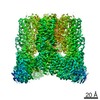




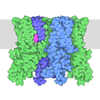
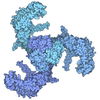
 Z (Sec.)
Z (Sec.) Y (Row.)
Y (Row.) X (Col.)
X (Col.)


















